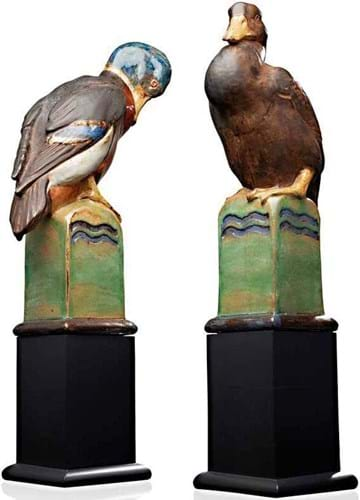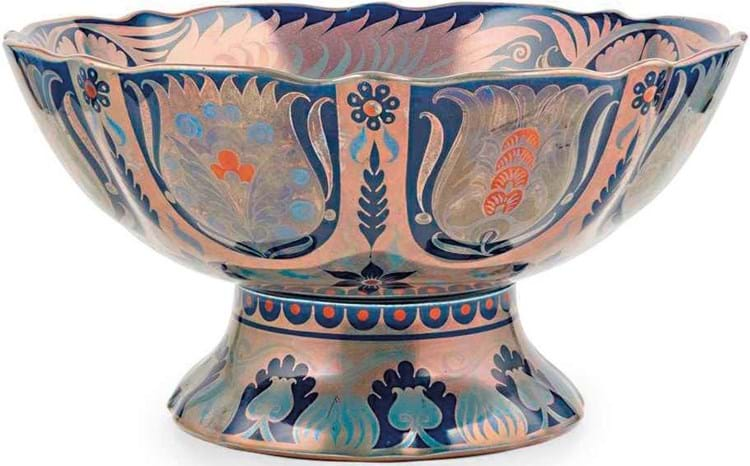It took almost two decades of experimentation before he mastered the three-colour lustre technique, each colour requiring its own firing with the light blue tone finally achieved via acid etching.
The complexity of the process made these pieces particularly expensive even by the standards of the Arts & Crafts movement and relatively few were sold.
De Morgan later said: “All my life I have been trying to make beautiful things, and now that I can make them nobody wants them.”
Today it is fair to say that many people want them.
Pictured here is a Moonlight and Sunset Suite 11½in (36cm) pedestal bowl that topped the Design since 1860 sale held by Lyon & Turnbull (25% buyer’s premium) in Edinburgh on October 20.
A bowl of this form is pictured in Martin Greenwood’s The Designs of William De Morgan (2007) while the central design of an owl and a mouse and a cat is known from tiles. It is signed with the initials FP for Fred Passenger.
Back in April L&T sold a similar dish by Passenger decorated with a heron amid bullrushes for £13,000. This piece, estimated at £4000-6000 took a significant step forward selling for £26,000,
It’s one of a series of healthy prices for De Morgan lustre wares in the past 12 months – just shy of the £27,000 bid at Martel Maides last November for a ‘double lustre’ charger decorated in the so-called Frightened Bird pattern. Painted in both ruby and gold lustre on a white ground, this was one of a group of six De Morgan dishes from a private collection, five of which sold to a bidder in Turkey.
Social conscience

Two Doulton Lambeth stoneware finials designed by Gilbert Bayes – £9500 at Lyon & Turnbull’s Lowood House sale.
A pair of Doulton Lambeth stoneware finials designed by sculptor Gilbert Bayes for a north London housing association in the 1930s were included in L&T’s Lowood House contents sale on October 6.
The finials, each measuring 19in (48cm) high, were part of the series made by the Doulton for the St Pancras Association Improvements Society. The aim was the provision of high-quality homes for the poorest tenants in the wake of the slum clearance scheme at Sidney Street in Somers Town.
The society’s architect was Ian BM Hamilton, the grandfather of the vendor. He designed all the flats with Bayes producing the relief mounded panels and washing line post finials he believed would enliven the new dwellings.
Duck finials of this kind were used at the Athlone Estate (1933-37) in Kentish Town with dragons, rose and thistle finials made for the York Rise Estate (1937-38) near Highgate Hill.
Now much coveted by collectors, all the original post finials for the project have been removed, although some original relief plaques and ornaments remain at Sidney Street. This pair estimated at £5000-7000 took £9500.
Salisbury auction house Woolley & Wallis has sold several St Pancras finials in recent memory including a dragon (£11,000 in 2009), two galleons (£6500 and £7000 in 2013) and a Christmas tree (£6000 in 2015).
In 2007 Dreweatts of Newbury sold a large Doulton roundel (Romance from a set of four also comprising Drama, Adventure and Terpsichore) designed by Bayes for the White Rock Pavilion, Hastings, for £6200.
Originally the ‘East Sussex Hospital’, the building was replaced with the White Rock Pavilion which was opened by Edward, Prince of Wales in April 1927. It was built for the Hastings Municipal Orchestra. The pavilion underwent a further revamp in 1937 and again in 1985 when it was renamed the White Rock Theatre.















